
- SAP Community
- Products and Technology
- Technology
- Technology Blogs by Members
- Build Android SAPUI5 OCR Scanner with SAP Web IDE ...
- Subscribe to RSS Feed
- Mark as New
- Mark as Read
- Bookmark
- Subscribe
- Printer Friendly Page
- Report Inappropriate Content
I would like to share how easy to build the Android SAP Fiori OCR Scanner to scan the barcode label and text.
Here are the screenshots of the final app that we are going to build.
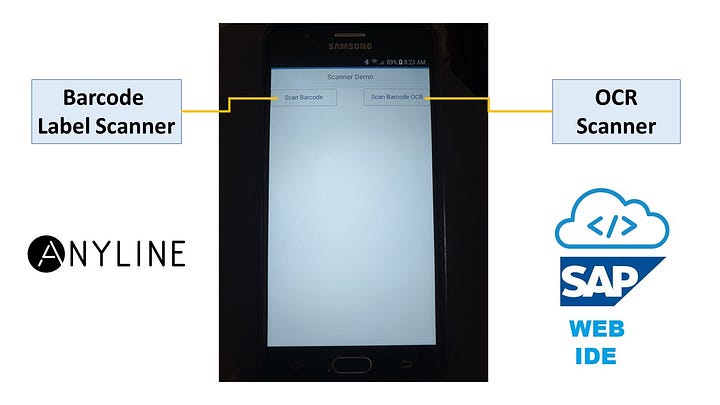
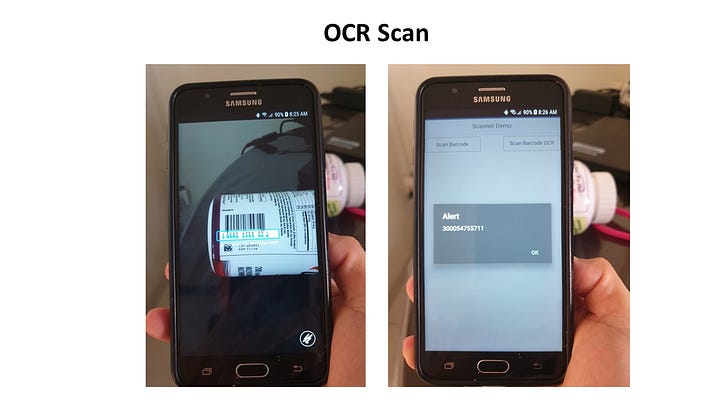
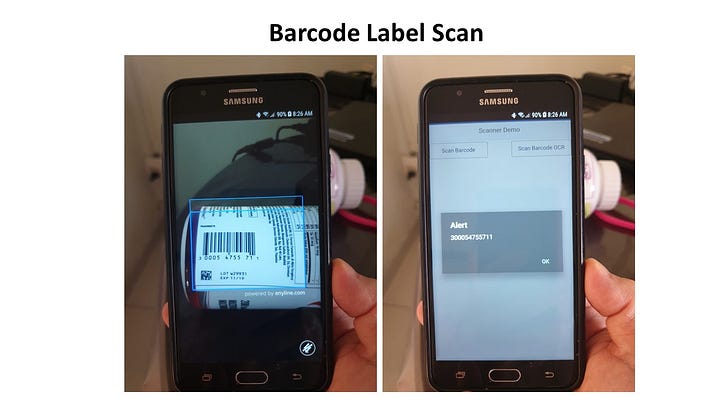
Configuration & Installation
We need to configure & install the following software.
- SAP Mobile Platform SDK
- SAP Web IDE Full Stack with HAT enabled
- SAP HAT Local Installation
- Anyline Cordova SDK
SAP Mobile Platform SDK
Download and install SAP Mobile Platform SDK from https://www.sap.com/sea/developer/trials-downloads/additional-downloads/mobile-platform-sdk-free-dow...
Install the following components. The version in the bracket is the version that I am currently using and is working perfectly.
- Oracle Java (1.8.0)
- Android SDK
- Android Studio (3.0.1)
- Cordova (6.5.0)
- Kapsel SDK (3.16.0)
- Ant (1.10.5)
Set the following environment variables: ANT_HOME, JAVA_HOME and KAPSEL_HOME.

SAP Web IDE Full Stack with HAT enabled
Logon to SAP Cloud Platform Cockpit and enable the SAP Web IDE Full Stack
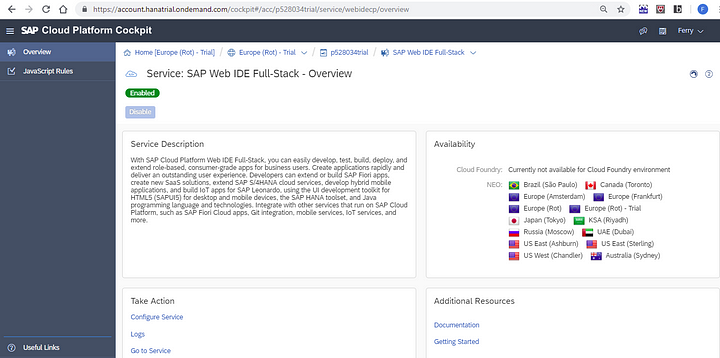
Then go to service.
Click Preferences > Features (Extensions) and search for Hybrid App Toolkit.
Enable and save it.
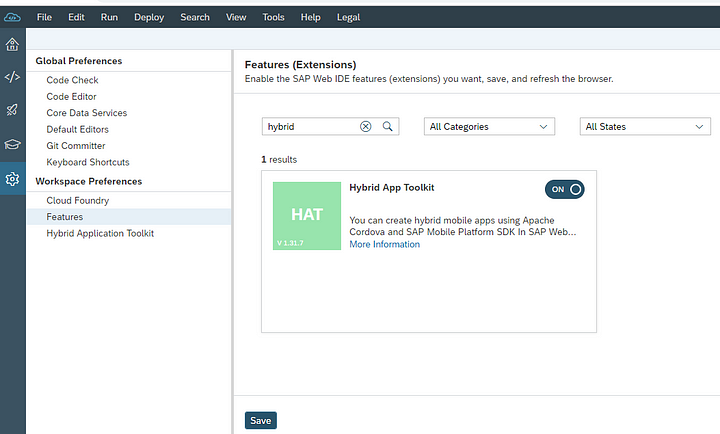
You will see the Hybrid App Toolkit.

Even though this feature has reached the end of maintenance, I can still use this feature to build the awesome apps and I find it easier.

Next step is to install the HAT locally on your computer.
SAP HAT Local Installation
Download the HAT from this link: https://www.sap.com/india/developer/trials-downloads/additional-downloads/hybrid-app-toolkit-add-on-...
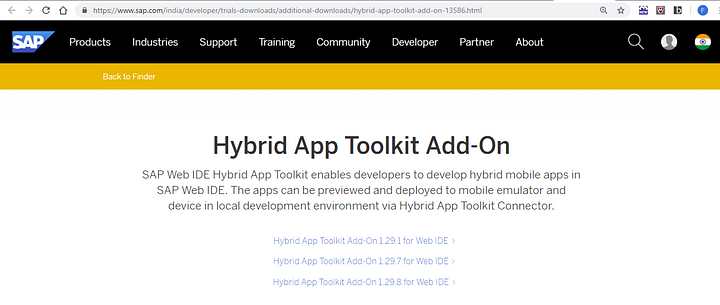
I downloaded version 1.29.7
Download the required components for HAT.
- NodeJS (8.9.4)
- Npm (5.6.0)
- Git (2.13.2)
- Bower (1.8.4)
Extract the HAT Add-on to your C:\ drive. For my case is C:\SAP_HAT_local-1.29.7
We need to modify the HAT Add-on setup script, otherwise you will get an error message.
Open check_env.cmd at folder .\SAP_HAT_local-1.29.7\setup\scripts\win and change the NodeJS version major, minor and build at line 62–64.
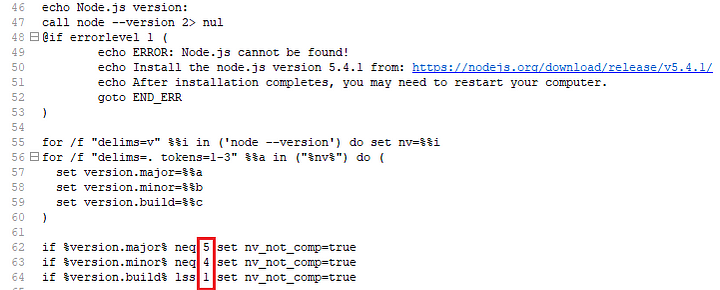
Change it according to your NodeJS version (for my case is 8.9.4):
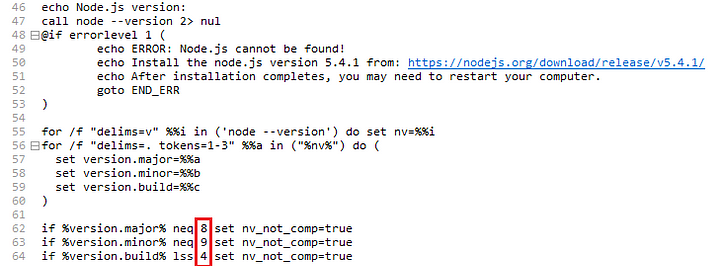
Run the setup.cmd.

If no error, the browser will be opened. Click Check All to start the installation.
Make sure there is no error on each step and status is passed.

When you at step 2.Install Hybrid App Toolkit > 3. Configure HAT Connector for SAP Web IDE, enter the SAP Web IDE Full Stack URL
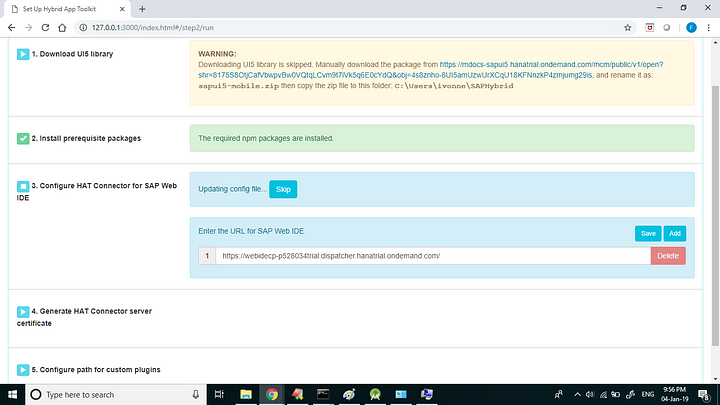
At step 5 Configure path for custom plugins, specify the folder where you want to put the Anyline SDK Cordova plugin (for my case is C:\SAP\Plugins). Later we will download this plugin.
Continue the installation.
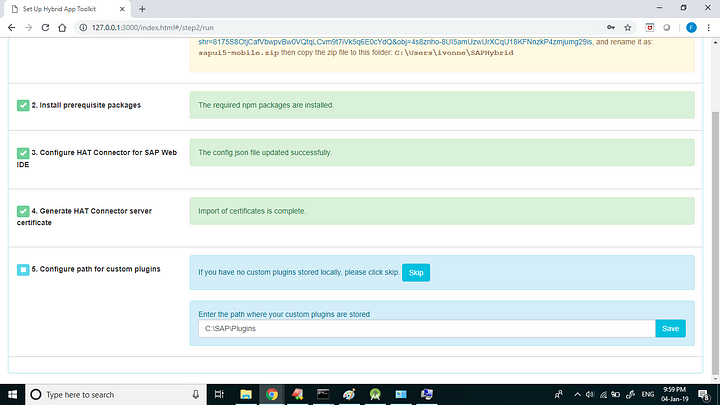
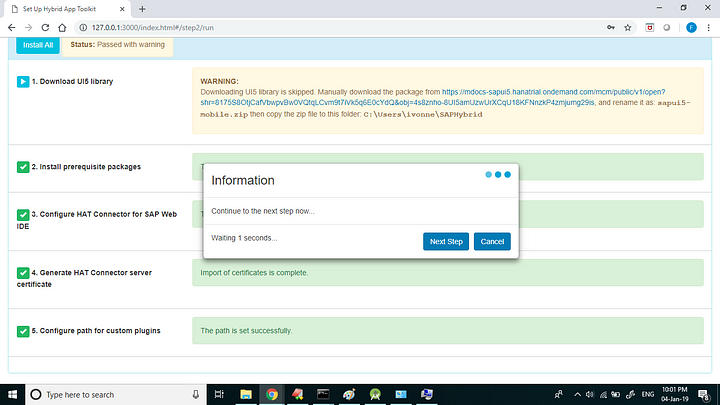
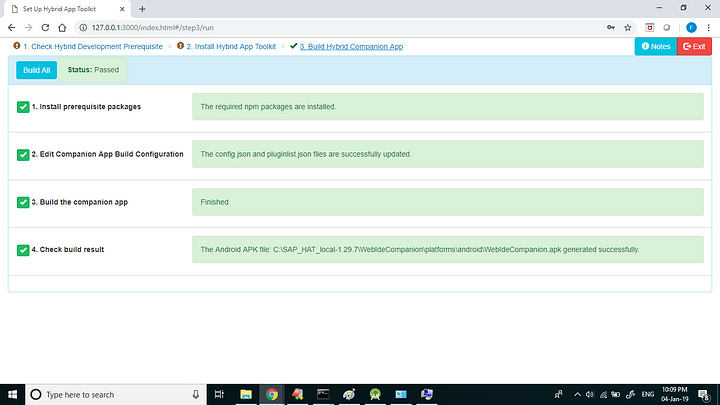
Check again to ensure there is no error and all steps are passed then close the browser.
Go to HAT Add-on folder installation and run the HAT server.

Check if SAP Web IDE can communicate to the server. Go to Web IDE > Hybrid Application Toolkit and test the connection. If no error, you will see the similar result as per the below screenshot.
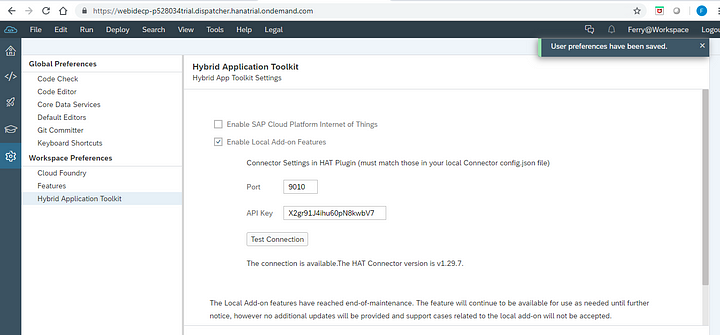
Anyline Cordova SDK

Create SAPUI5 App
On SAP Web IDE, create the SAPUI5 app Scanner.



Click Finish to complete.
Go to Project Settings.
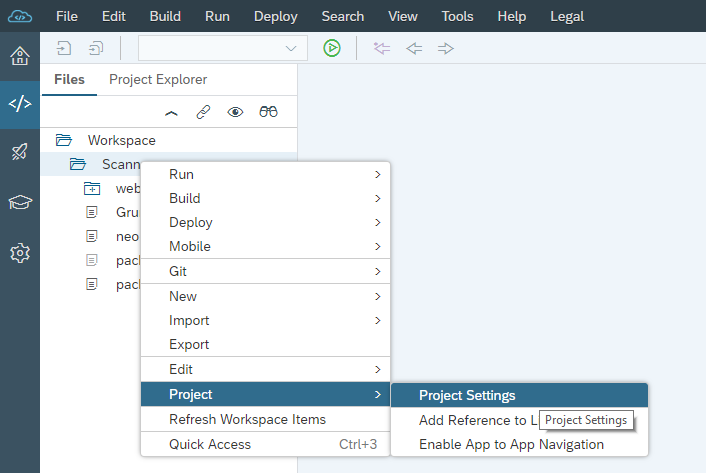
Select Hybrid App Toolkit > App Configuration > Application
Enter the App Name and App Id.

Select Hybrid App Toolkit > App Configuration > Plugins > Custom.
Select Local > AnylineSDK
Click Save
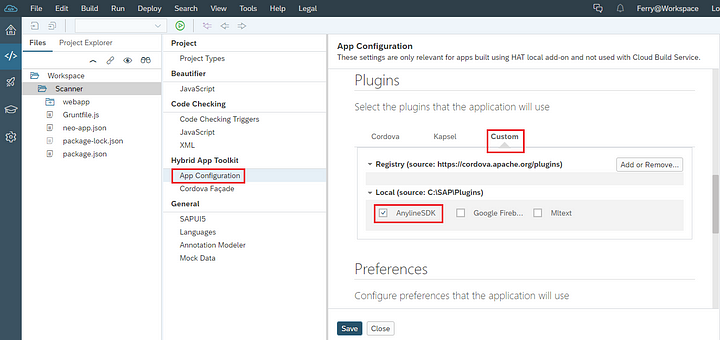
Click Deploy > Prepare Hybrid Project.
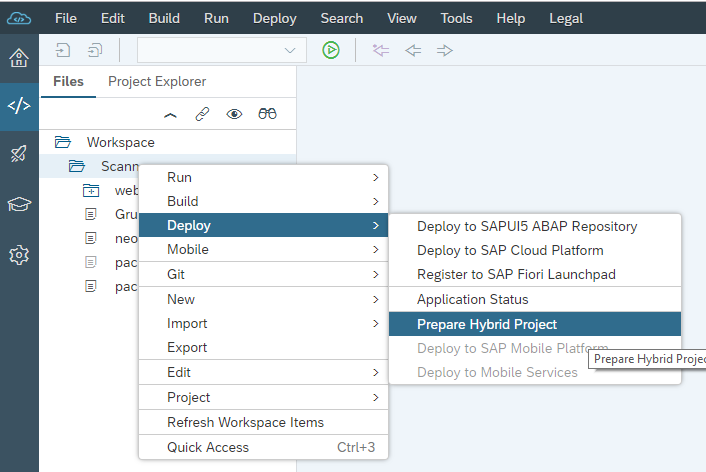
You will see the progress on the console. One of the activity is to install the Anyline Cordova plugin locally.
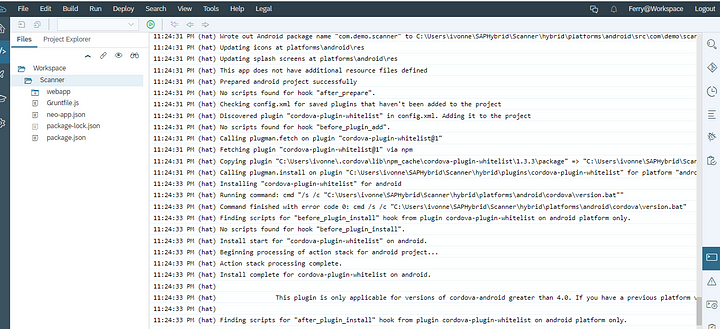
Wait until the app has been successfully deployed.

It will be saved at C:\Users\<user>\SAPHybrid\Scanner.

Open Android Studio and import the project at C:\Users\<user>\SAPHybrid\Scanner\hybrid\platforms\android
If you see this error message:

Open gradle-wrapper.properties, change distributionUrl to:
Open gradle-wrapper.properties, change distributionUrl to:
distributionUrl=https\://services.gradle.org/distributions/gradle-4.6-all.zip

buildscript {
repositories {
mavenCentral()
google()
jcenter()
}
// Switch the Android Gradle plugin version requirement depending on the
// installed version of Gradle. This dependency is documented at
// http://tools.android.com/tech-docs/new-build-system/version-compatibility
// and https://issues.apache.org/jira/browse/CB-8143
dependencies {
classpath 'com.android.tools.build:gradle:3.2.1'
}
}
// Allow plugins to declare Maven dependencies via build-extras.gradle.
allprojects {
repositories {
mavenCentral();
google()
jcenter()
}
}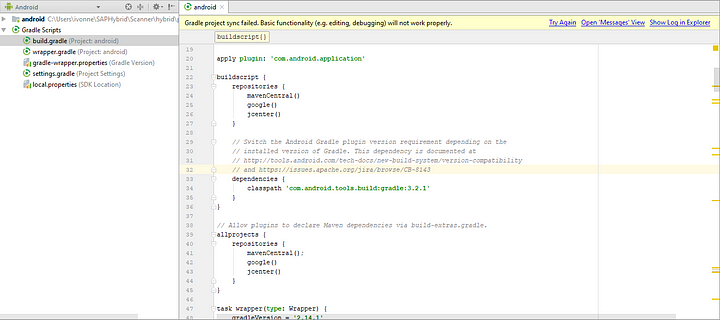
dependencies {
compile fileTree(dir: 'libs', include: '*.jar')
// SUB-PROJECT DEPENDENCIES START
//debugCompile(project(path: "CordovaLib", configuration: "debug"))
//releaseCompile(project(path: "CordovaLib", configuration: "release"))
compile project(':CordovaLib')
// SUB-PROJECT DEPENDENCIES END
}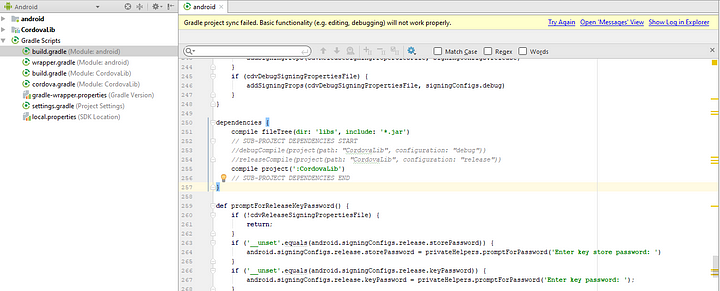
Remove uses-sdk tag on AndroidManifest.xml.
<uses-sdk android:minSdkVersion="16" android:targetSdkVersion="25" />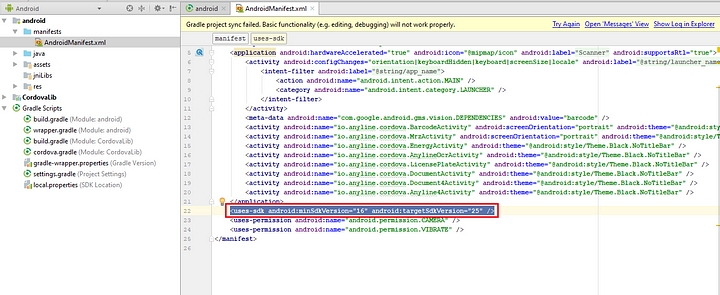
Also remove uses-sdk on AndroidManifest.xml at CordovaLib level:
<uses-sdk android:minSdkVersion="14" />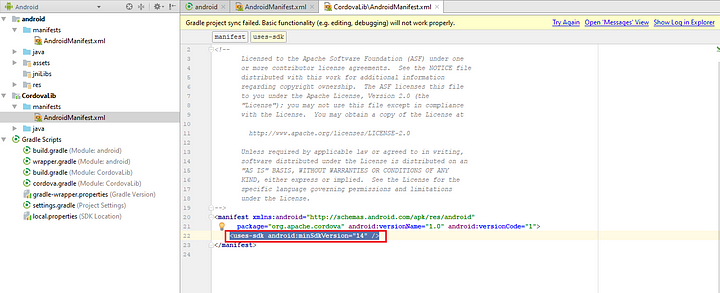
Try to rebuild again.
Now the build is success!

The main functions to scan the barcode and OCR are in the the Scanner.controller.js.
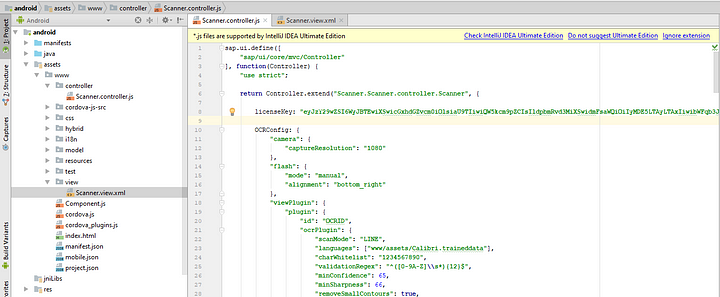
Make sure the asset folder is there. It consist of the available trained fonts that will be used to recognize the character in the scanning process. We are going to use only the Calibri.traineddata for this project. Feel free to experiment with other asset files if the scan result is poor.
https://github.com/ferrygun/Scanner/tree/master/webapp/assets

Let’s take a look at the main function in Scanner.controller.js before we build the app. We need to define the Anyline OCR & Barcode configuration as described below.
Anyline OCR config
OCRConfig: {
"camera": {
"captureResolution": "1080"
},
"flash": {
"mode": "manual",
"alignment": "bottom_right"
},
"viewPlugin": {
"plugin": {
"id": "OCRID",
"ocrPlugin": {
"scanMode": "LINE",
"languages": ["www/assets/Calibri.traineddata"],
"charWhitelist": "1234567890",
"validationRegex": "^[0-9]{12}$",
"minConfidence": 60,
"minSharpness": 66,
"removeSmallContours": true,
"removeWhitespaces": true
}
},
"cutoutConfig": {
"style": "rect",
"maxWidthPercent": "80%",
"maxHeightPercent": "80%",
"alignment": "center",
"width": 500,
"ratioFromSize": {
"width": 720,
"height": 95
},
"strokeWidth": 2,
"cornerRadius": 3,
"strokeColor": "FFFFFF",
"outerColor": "000000",
"outerAlpha": 0.3,
"feedbackStrokeColor": "0099FF"
},
"scanFeedback": {
"style": "contour_point",
"strokeWidth": 3,
"strokeColor": "0099FF",
"fillColor": "220099FF",
"beepOnResult": true,
"vibrateOnResult": true,
"blinkAnimationOnResult": true
},
"visualFeedback": {
"style": "contour_point",
"animation": "resize",
"animationDuration": 150,
"strokeColor": "0099FF",
"strokeWidth": 2
},
"cancelOnResult": true
}
},Anyline Barcode config
BarcodeConfig: {
"camera": {
"captureResolution": "1080"
},
"flash": {
"mode": "manual",
"alignment": "bottom_right"
},
"viewPlugin": {
"plugin": {
"id": "BarcodeID",
"barcodePlugin": {
"barcodeFormatOptions": ["CODABAR", "EAN_13", "UPC_A"]
}
},
"cutoutConfig": {
"style": "rect",
"maxWidthPercent": "80%",
"maxHeightPercent": "80%",
"alignment": "center",
"ratioFromSize": {
"width": 100,
"height": 80
},
"strokeWidth": 1,
"cornerRadius": 3,
"strokeColor": "FFFFFF",
"outerColor": "000000",
"outerAlpha": 0.3,
"feedbackStrokeColor": "0099FF"
},
"scanFeedback": {
"style": "rect",
"strokeColor": "0099FF",
"fillColor": "220099FF",
"animationDuration": 150,
"blinkOnResult": true,
"beepOnResult": true,
"vibrateOnResult": true
},
"cancelOnResult": true
}
},These two functions getBarcode() and getOCR() to call cordova barcode label and OCR scanner.
getBarcode: function() {
cordova.exec(this.onResultBarcode, this.onError, "AnylineSDK", "scan", [this.licenseKey, this.BarcodeConfig]);
},
getOCR: function() {
cordova.exec(this.onResultOCR, this.onError, "AnylineSDK", "scan", [this.licenseKey, this.OCRConfig]);
},
onResultOCR: function(result) {
console.log(result);
alert(result.text);
},
onResultBarcode: function(result) {
console.log(result);
alert(result.value);
},Now everything is setup and we are ready to build & run the app !
All the codes can be found here: https://github.com/ferrygun/Scanner
- SAP Managed Tags:
- SAPUI5,
- SAP Web IDE
You must be a registered user to add a comment. If you've already registered, sign in. Otherwise, register and sign in.
-
"automatische backups"
1 -
"regelmäßige sicherung"
1 -
"TypeScript" "Development" "FeedBack"
1 -
505 Technology Updates 53
1 -
ABAP
14 -
ABAP API
1 -
ABAP CDS Views
2 -
ABAP CDS Views - BW Extraction
1 -
ABAP CDS Views - CDC (Change Data Capture)
1 -
ABAP class
2 -
ABAP Cloud
2 -
ABAP Development
5 -
ABAP in Eclipse
1 -
ABAP Platform Trial
1 -
ABAP Programming
2 -
abap technical
1 -
absl
2 -
access data from SAP Datasphere directly from Snowflake
1 -
Access data from SAP datasphere to Qliksense
1 -
Accrual
1 -
action
1 -
adapter modules
1 -
Addon
1 -
Adobe Document Services
1 -
ADS
1 -
ADS Config
1 -
ADS with ABAP
1 -
ADS with Java
1 -
ADT
2 -
Advance Shipping and Receiving
1 -
Advanced Event Mesh
3 -
AEM
1 -
AI
7 -
AI Launchpad
1 -
AI Projects
1 -
AIML
9 -
Alert in Sap analytical cloud
1 -
Amazon S3
1 -
Analytical Dataset
1 -
Analytical Model
1 -
Analytics
1 -
Analyze Workload Data
1 -
annotations
1 -
API
1 -
API and Integration
3 -
API Call
2 -
Application Architecture
1 -
Application Development
5 -
Application Development for SAP HANA Cloud
3 -
Applications and Business Processes (AP)
1 -
Artificial Intelligence
1 -
Artificial Intelligence (AI)
5 -
Artificial Intelligence (AI) 1 Business Trends 363 Business Trends 8 Digital Transformation with Cloud ERP (DT) 1 Event Information 462 Event Information 15 Expert Insights 114 Expert Insights 76 Life at SAP 418 Life at SAP 1 Product Updates 4
1 -
Artificial Intelligence (AI) blockchain Data & Analytics
1 -
Artificial Intelligence (AI) blockchain Data & Analytics Intelligent Enterprise
1 -
Artificial Intelligence (AI) blockchain Data & Analytics Intelligent Enterprise Oil Gas IoT Exploration Production
1 -
Artificial Intelligence (AI) blockchain Data & Analytics Intelligent Enterprise sustainability responsibility esg social compliance cybersecurity risk
1 -
ASE
1 -
ASR
2 -
ASUG
1 -
Attachments
1 -
Authorisations
1 -
Automating Processes
1 -
Automation
2 -
aws
2 -
Azure
1 -
Azure AI Studio
1 -
B2B Integration
1 -
Backorder Processing
1 -
Backup
1 -
Backup and Recovery
1 -
Backup schedule
1 -
BADI_MATERIAL_CHECK error message
1 -
Bank
1 -
BAS
1 -
basis
2 -
Basis Monitoring & Tcodes with Key notes
2 -
Batch Management
1 -
BDC
1 -
Best Practice
1 -
bitcoin
1 -
Blockchain
3 -
bodl
1 -
BOP in aATP
1 -
BOP Segments
1 -
BOP Strategies
1 -
BOP Variant
1 -
BPC
1 -
BPC LIVE
1 -
BTP
12 -
BTP Destination
2 -
Business AI
1 -
Business and IT Integration
1 -
Business application stu
1 -
Business Application Studio
1 -
Business Architecture
1 -
Business Communication Services
1 -
Business Continuity
1 -
Business Data Fabric
3 -
Business Partner
12 -
Business Partner Master Data
10 -
Business Technology Platform
2 -
Business Trends
4 -
CA
1 -
calculation view
1 -
CAP
3 -
Capgemini
1 -
CAPM
1 -
Catalyst for Efficiency: Revolutionizing SAP Integration Suite with Artificial Intelligence (AI) and
1 -
CCMS
2 -
CDQ
12 -
CDS
2 -
Cental Finance
1 -
Certificates
1 -
CFL
1 -
Change Management
1 -
chatbot
1 -
chatgpt
3 -
CL_SALV_TABLE
2 -
Class Runner
1 -
Classrunner
1 -
Cloud ALM Monitoring
1 -
Cloud ALM Operations
1 -
cloud connector
1 -
Cloud Extensibility
1 -
Cloud Foundry
4 -
Cloud Integration
6 -
Cloud Platform Integration
2 -
cloudalm
1 -
communication
1 -
Compensation Information Management
1 -
Compensation Management
1 -
Compliance
1 -
Compound Employee API
1 -
Configuration
1 -
Connectors
1 -
Consolidation Extension for SAP Analytics Cloud
2 -
Control Indicators.
1 -
Controller-Service-Repository pattern
1 -
Conversion
1 -
Cosine similarity
1 -
cryptocurrency
1 -
CSI
1 -
ctms
1 -
Custom chatbot
3 -
Custom Destination Service
1 -
custom fields
1 -
Customer Experience
1 -
Customer Journey
1 -
Customizing
1 -
cyber security
3 -
cybersecurity
1 -
Data
1 -
Data & Analytics
1 -
Data Aging
1 -
Data Analytics
2 -
Data and Analytics (DA)
1 -
Data Archiving
1 -
Data Back-up
1 -
Data Flow
1 -
Data Governance
5 -
Data Integration
2 -
Data Quality
12 -
Data Quality Management
12 -
Data Synchronization
1 -
data transfer
1 -
Data Unleashed
1 -
Data Value
8 -
database tables
1 -
Datasphere
3 -
datenbanksicherung
1 -
dba cockpit
1 -
dbacockpit
1 -
Debugging
2 -
Delimiting Pay Components
1 -
Delta Integrations
1 -
Destination
3 -
Destination Service
1 -
Developer extensibility
1 -
Developing with SAP Integration Suite
1 -
Devops
1 -
digital transformation
1 -
Documentation
1 -
Dot Product
1 -
DQM
1 -
dump database
1 -
dump transaction
1 -
e-Invoice
1 -
E4H Conversion
1 -
Eclipse ADT ABAP Development Tools
2 -
edoc
1 -
edocument
1 -
ELA
1 -
Embedded Consolidation
1 -
Embedding
1 -
Embeddings
1 -
Employee Central
1 -
Employee Central Payroll
1 -
Employee Central Time Off
1 -
Employee Information
1 -
Employee Rehires
1 -
Enable Now
1 -
Enable now manager
1 -
endpoint
1 -
Enhancement Request
1 -
Enterprise Architecture
1 -
ETL Business Analytics with SAP Signavio
1 -
Euclidean distance
1 -
Event Dates
1 -
Event Driven Architecture
1 -
Event Mesh
2 -
Event Reason
1 -
EventBasedIntegration
1 -
EWM
1 -
EWM Outbound configuration
1 -
EWM-TM-Integration
1 -
Existing Event Changes
1 -
Expand
1 -
Expert
2 -
Expert Insights
2 -
Exploits
1 -
Fiori
14 -
Fiori Elements
2 -
Fiori SAPUI5
12 -
Flask
1 -
Full Stack
8 -
Funds Management
1 -
General
1 -
General Splitter
1 -
Generative AI
1 -
Getting Started
1 -
GitHub
8 -
Grants Management
1 -
GraphQL
1 -
groovy
1 -
GTP
1 -
HANA
6 -
HANA Cloud
2 -
Hana Cloud Database Integration
2 -
HANA DB
2 -
HANA XS Advanced
1 -
Historical Events
1 -
home labs
1 -
HowTo
1 -
HR Data Management
1 -
html5
8 -
HTML5 Application
1 -
Identity cards validation
1 -
idm
1 -
Implementation
1 -
input parameter
1 -
instant payments
1 -
Integration
3 -
Integration Advisor
1 -
Integration Architecture
1 -
Integration Center
1 -
Integration Suite
1 -
intelligent enterprise
1 -
iot
1 -
Java
1 -
job
1 -
Job Information Changes
1 -
Job-Related Events
1 -
Job_Event_Information
1 -
joule
4 -
Journal Entries
1 -
Just Ask
1 -
Kerberos for ABAP
8 -
Kerberos for JAVA
8 -
KNN
1 -
Launch Wizard
1 -
Learning Content
2 -
Life at SAP
5 -
lightning
1 -
Linear Regression SAP HANA Cloud
1 -
Loading Indicator
1 -
local tax regulations
1 -
LP
1 -
Machine Learning
2 -
Marketing
1 -
Master Data
3 -
Master Data Management
14 -
Maxdb
2 -
MDG
1 -
MDGM
1 -
MDM
1 -
Message box.
1 -
Messages on RF Device
1 -
Microservices Architecture
1 -
Microsoft Universal Print
1 -
Middleware Solutions
1 -
Migration
5 -
ML Model Development
1 -
Modeling in SAP HANA Cloud
8 -
Monitoring
3 -
MTA
1 -
Multi-Record Scenarios
1 -
Multiple Event Triggers
1 -
Myself Transformation
1 -
Neo
1 -
New Event Creation
1 -
New Feature
1 -
Newcomer
1 -
NodeJS
2 -
ODATA
2 -
OData APIs
1 -
odatav2
1 -
ODATAV4
1 -
ODBC
1 -
ODBC Connection
1 -
Onpremise
1 -
open source
2 -
OpenAI API
1 -
Oracle
1 -
PaPM
1 -
PaPM Dynamic Data Copy through Writer function
1 -
PaPM Remote Call
1 -
PAS-C01
1 -
Pay Component Management
1 -
PGP
1 -
Pickle
1 -
PLANNING ARCHITECTURE
1 -
Popup in Sap analytical cloud
1 -
PostgrSQL
1 -
POSTMAN
1 -
Process Automation
2 -
Product Updates
4 -
PSM
1 -
Public Cloud
1 -
Python
4 -
Qlik
1 -
Qualtrics
1 -
RAP
3 -
RAP BO
2 -
Record Deletion
1 -
Recovery
1 -
recurring payments
1 -
redeply
1 -
Release
1 -
Remote Consumption Model
1 -
Replication Flows
1 -
research
1 -
Resilience
1 -
REST
1 -
REST API
2 -
Retagging Required
1 -
Risk
1 -
Rolling Kernel Switch
1 -
route
1 -
rules
1 -
S4 HANA
1 -
S4 HANA Cloud
1 -
S4 HANA On-Premise
1 -
S4HANA
3 -
S4HANA_OP_2023
2 -
SAC
10 -
SAC PLANNING
9 -
SAP
4 -
SAP ABAP
1 -
SAP Advanced Event Mesh
1 -
SAP AI Core
8 -
SAP AI Launchpad
8 -
SAP Analytic Cloud Compass
1 -
Sap Analytical Cloud
1 -
SAP Analytics Cloud
4 -
SAP Analytics Cloud for Consolidation
3 -
SAP Analytics Cloud Story
1 -
SAP analytics clouds
1 -
SAP BAS
1 -
SAP Basis
6 -
SAP BODS
1 -
SAP BODS certification.
1 -
SAP BTP
21 -
SAP BTP Build Work Zone
2 -
SAP BTP Cloud Foundry
6 -
SAP BTP Costing
1 -
SAP BTP CTMS
1 -
SAP BTP Innovation
1 -
SAP BTP Migration Tool
1 -
SAP BTP SDK IOS
1 -
SAP Build
11 -
SAP Build App
1 -
SAP Build apps
1 -
SAP Build CodeJam
1 -
SAP Build Process Automation
3 -
SAP Build work zone
10 -
SAP Business Objects Platform
1 -
SAP Business Technology
2 -
SAP Business Technology Platform (XP)
1 -
sap bw
1 -
SAP CAP
2 -
SAP CDC
1 -
SAP CDP
1 -
SAP CDS VIEW
1 -
SAP Certification
1 -
SAP Cloud ALM
4 -
SAP Cloud Application Programming Model
1 -
SAP Cloud Integration for Data Services
1 -
SAP cloud platform
8 -
SAP Companion
1 -
SAP CPI
3 -
SAP CPI (Cloud Platform Integration)
2 -
SAP CPI Discover tab
1 -
sap credential store
1 -
SAP Customer Data Cloud
1 -
SAP Customer Data Platform
1 -
SAP Data Intelligence
1 -
SAP Data Migration in Retail Industry
1 -
SAP Data Services
1 -
SAP DATABASE
1 -
SAP Dataspher to Non SAP BI tools
1 -
SAP Datasphere
9 -
SAP DRC
1 -
SAP EWM
1 -
SAP Fiori
3 -
SAP Fiori App Embedding
1 -
Sap Fiori Extension Project Using BAS
1 -
SAP GRC
1 -
SAP HANA
1 -
SAP HCM (Human Capital Management)
1 -
SAP HR Solutions
1 -
SAP IDM
1 -
SAP Integration Suite
9 -
SAP Integrations
4 -
SAP iRPA
2 -
SAP LAGGING AND SLOW
1 -
SAP Learning Class
1 -
SAP Learning Hub
1 -
SAP Odata
2 -
SAP on Azure
1 -
SAP PartnerEdge
1 -
sap partners
1 -
SAP Password Reset
1 -
SAP PO Migration
1 -
SAP Prepackaged Content
1 -
SAP Process Automation
2 -
SAP Process Integration
2 -
SAP Process Orchestration
1 -
SAP S4HANA
2 -
SAP S4HANA Cloud
1 -
SAP S4HANA Cloud for Finance
1 -
SAP S4HANA Cloud private edition
1 -
SAP Sandbox
1 -
SAP STMS
1 -
SAP successfactors
3 -
SAP SuccessFactors HXM Core
1 -
SAP Time
1 -
SAP TM
2 -
SAP Trading Partner Management
1 -
SAP UI5
1 -
SAP Upgrade
1 -
SAP Utilities
1 -
SAP-GUI
8 -
SAP_COM_0276
1 -
SAPBTP
1 -
SAPCPI
1 -
SAPEWM
1 -
sapmentors
1 -
saponaws
2 -
SAPS4HANA
1 -
SAPUI5
5 -
schedule
1 -
Script Operator
1 -
Secure Login Client Setup
8 -
security
9 -
Selenium Testing
1 -
Self Transformation
1 -
Self-Transformation
1 -
SEN
1 -
SEN Manager
1 -
service
1 -
SET_CELL_TYPE
1 -
SET_CELL_TYPE_COLUMN
1 -
SFTP scenario
2 -
Simplex
1 -
Single Sign On
8 -
Singlesource
1 -
SKLearn
1 -
Slow loading
1 -
soap
1 -
Software Development
1 -
SOLMAN
1 -
solman 7.2
2 -
Solution Manager
3 -
sp_dumpdb
1 -
sp_dumptrans
1 -
SQL
1 -
sql script
1 -
SSL
8 -
SSO
8 -
Substring function
1 -
SuccessFactors
1 -
SuccessFactors Platform
1 -
SuccessFactors Time Tracking
1 -
Sybase
1 -
system copy method
1 -
System owner
1 -
Table splitting
1 -
Tax Integration
1 -
Technical article
1 -
Technical articles
1 -
Technology Updates
14 -
Technology Updates
1 -
Technology_Updates
1 -
terraform
1 -
Threats
2 -
Time Collectors
1 -
Time Off
2 -
Time Sheet
1 -
Time Sheet SAP SuccessFactors Time Tracking
1 -
Tips and tricks
2 -
toggle button
1 -
Tools
1 -
Trainings & Certifications
1 -
Transformation Flow
1 -
Transport in SAP BODS
1 -
Transport Management
1 -
TypeScript
2 -
ui designer
1 -
unbind
1 -
Unified Customer Profile
1 -
UPB
1 -
Use of Parameters for Data Copy in PaPM
1 -
User Unlock
1 -
VA02
1 -
Validations
1 -
Vector Database
2 -
Vector Engine
1 -
Visual Studio Code
1 -
VSCode
1 -
Vulnerabilities
1 -
Web SDK
1 -
work zone
1 -
workload
1 -
xsa
1 -
XSA Refresh
1
- « Previous
- Next »
- SAP BTP SDK for Android 24.4.0 is now available in Technology Blogs by SAP
- SAP MDK OnValueChange event issue in Technology Q&A
- Is there a roadmap for "Camera on the Web" and/or "BTP Authentication in Android App"? in Technology Q&A
- MDK - Determine when user closes Barcode Scanner in Technology Q&A
- SAPUI5 rendering issue on Android-based barcode scanner devices in Technology Q&A
| User | Count |
|---|---|
| 6 | |
| 5 | |
| 5 | |
| 5 | |
| 5 | |
| 4 | |
| 4 | |
| 4 | |
| 3 | |
| 3 |